十大透明动物 - BBC艾拉·戴维斯 (Ella Davies)(2023年6月19日)

一只玻璃章鱼 (拉丁学名:Vitreledonella richardi) (图片来源: Solvin Zankl/NPL)
玻璃章鱼 (拉丁学名:Vitreledonella richardi)
玻璃章鱼当属最神秘的生物之一。它们几近透明,隐蔽在深海中,难以寻觅。只有消化器官和眼睛是不透明的。
玻璃章鱼不像同样居住在深海的其它生物那样拥有大大的圆眼睛,它们的眼睛从外面看几乎是矩形的,事实上是个管状器官,其一头是水晶体,另一头是视网膜。这对眼睛向上竖起,以便收集射到深海里的微弱光线。
这种圆柱形的眼睛能够帮助章鱼在无法藏身的开阔海域中进行伪装。在海底,透明章鱼眼睛的影子比起其他种类章鱼那种半球状眼睛影子小很多。
乍波蛸(Japetella octopus) 同样也是透明的。它们还有另一个技能:可以躲避自体发光的捕食者。2011年,科学家发现,如果捕食者光线照在它们身上,它们就变成暗红色。
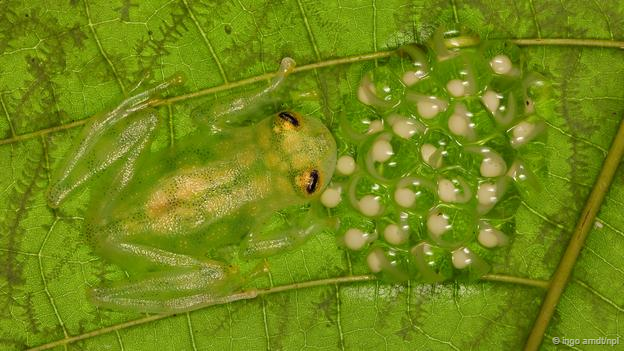
一只拉帕尔马玻璃青蛙和它的卵 (拉丁学名:Hyalinobatrachium valerioi) (图片来源:Ingo Arndt/NPL)
玻璃青蛙 (拉丁学名:Centrolenidae)
玻璃青蛙是在中南美洲被发现的,主要生长在雾林里。因其皮肤透明而得名。
这个家族的100个物种里大部分都有着半透明的肚皮,可以看到他们的器官、骨骼和血管。有些物种的骨骼也是绿色的,有些器官也是半透明的。
目前还不太清楚为何他们的腹部是透明的。它们的后背呈亮绿色,这样能够让他们伪装在所栖息的嫩绿树叶中。
2023年,在智利瓜亚坎发现了一种叫Hyalinobatrachium dianae的新物种,发现者是哥斯达黎加爬行动物研究中心的布莱恩.库彼琪(Brian Kubicki)和他的同事们。这种青蛙有着浅黄绿色皮肤,长得像布偶秀里面的科米蛙,能发出长长的金属般的口哨声。
当时,库彼琪对BBC说,玻璃青蛙是一种“精致”的生物。
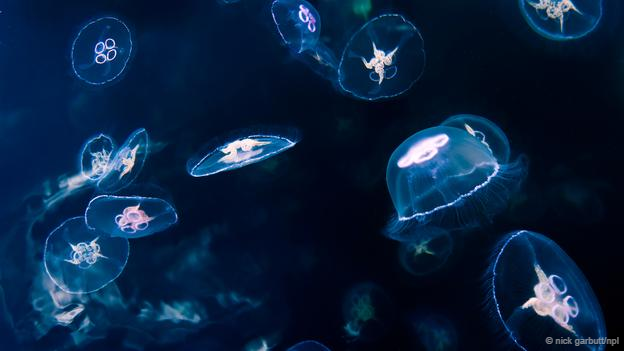
一群月亮水母 (拉丁学名:Aurelia aurita) (图片来源: Nick Garbutt/NPL)
月亮水母 ( 拉丁学名: Aurelia aurita)
虽然在水下摄影师的光线下,月亮水母看起来像一个发光球体,它们名字实际上跟它们四个马蹄型的器官有关,能透过外伞看得一清二楚。这些是可再生的器官。雄性水母的器官呈白色,雌性水母的呈淡粉色。
月亮水母应该属于最常见的一种透明动物了,尤其在欧洲海岸,因为它们会经常被冲刷到海岸线上。
月亮水母如果没有像只粘糊糊的塑料袋一样躺在你堆的沙堡旁边,那么它们就是在海面附近的水域游曳。在这里,它们通过充满粘液的钟形外表困住浮游生物,再将它们吞入口中消化掉。
月亮水母还会通过摇晃触角来获得更大的食物。这些触角和外伞边缘都布满刺细胞,可以麻痹从旁边游过的小鱼。
月亮水母不会给人类带来太大疼痛,但也能引起麻烦。有好几个核电站由于其冷却系统被这些无脑生物给侵占而不得不关闭核反应堆。大群的水母很有可能变得司空见惯。
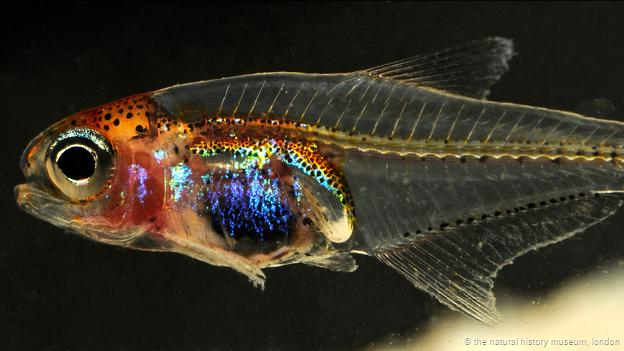
蓝肚鱼具有半透明身体 (图片来源: Natural History Museum, London)
蓝肚鱼
这种鱼被人所知时间不长。它的拉丁学名原意是“蓝色肚皮的夜行者”。这个名字基本说明了它的外观和生活习性,但没有说的是,除了腹部和头部外,这种鱼几乎是透明的。
大多数鱼在幼年期都是透明的,因为这样可以帮助它们在发育成熟之前进行伪装。蓝肚鱼长成熟后却仍然透明,个头也不会长很大。
蓝肚鱼是科学家在2011年在巴西的尼格罗河发现的,身长仅有17毫米(0.7英寸)。只比世界上最小的鱼种露比精灵(Paedocypris progenetica)长7毫米。
蓝肚鱼是一个令人惊讶的发现,因为科学家们认为它们的栖息地,亚马逊河流域最大的支流,已经被充分的发掘过了。在此之后,研究人员们又在圣保罗大学的动物学博物馆里找到了更多的物种。它们被遗忘了近30年。
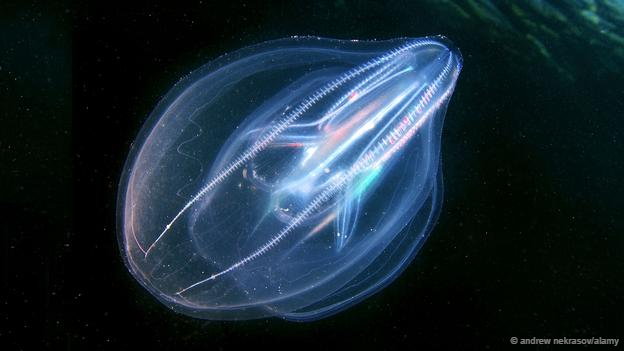
一只海核桃 (拉丁学名:Mnemiopsis leidyi) (图片来源:Andrew Nekrasov/Alamy)
海核桃 (拉丁学名:Mnemiopsis leidyi)
行动迟缓,既没有眼睛也没有大脑,而且看起来就像个透明的圆块儿,这就是海核桃。这种动物的名字就源于它们那无生命感的外形。
它们不是水母,而是栉水母。水母采用喷水推进的方式游动,而栉水母靠着一排排微小的、头发般的组织颤动。这些组织长得像梳齿一样,因而得名。
海核桃是透明的,但它们的梳齿状组织将光线发散成彩虹般的七彩。在照片中制造出一圈线状的霓虹灯光芒。这种动物还能通过一种叫光细胞的特殊细胞制造出蓝绿色的生物荧光。
海核桃利用它们的梳齿来困住猎物,将海水中的浮游生物直接送进口中。海核桃的食量很大,能够对入侵地区的食物链造成很大负面影响。
它们被意外的由货船传至黑海,沿途海域绝大部分浮游生物都被掠食,以浮游生物为食的鱼类都受到影响。甚至大型海洋动物,如海豚和海豹的数量也减少了。
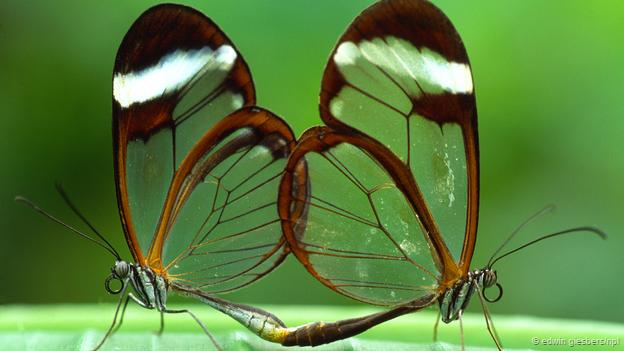
一对玻璃翅蝴蝶 (拉丁学名:Greta oto) (图片来源: Edwin Giesbers/NPL)
玻璃翅蝴蝶 (拉丁学名:Greta oto)
蝴蝶因色彩夺目而著称。靓丽炫目的品种,诸如凤蝶,靠的就是他们迷人的色彩来沟通和吸引伴侣。
有些品种通过翅膀内侧隐晦的颜色来躲避捕食者。但是没有一个品种像中美地区的玻璃翅蝴蝶那样。你一定猜到了,它们的翅膀是透明的。
蝴蝶翅膀的缤纷颜色是由极微小的鳞片制造出来的。但是玻璃翅上绝大部分没有鳞片,这样就形成了可以看到背景的窗户。
更令人惊叹的是,这些翅膀几乎不反射光线,哪怕是一点点意外的闪光也都不会让蝴蝶暴露。这得益于翅膀的纳米级构造。
2023年的一项研究描述了翅膀上的这些微小柱状结构,这些结构无论从形状还是大小上都是“混乱的”。这样的结构实质上是降低了反射。这种结构在未来可以被应用在不反光的电脑屏幕及手机上。
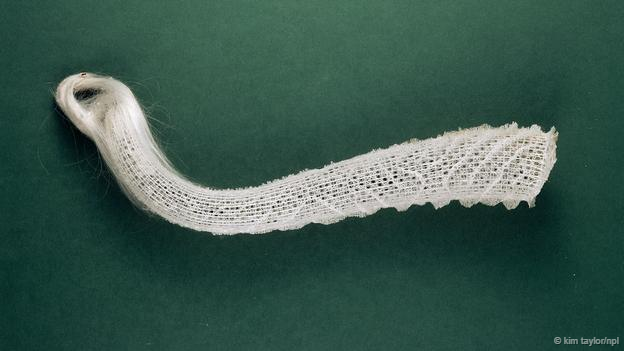
一只维纳斯花篮 (拉丁学名:Euplectella aspergillum) (图片来源:Kim Taylor/NPL)
维纳斯花篮(拉丁学名:Euplectella aspergillum)
在众多能拿来跟玻璃相比的透明物种当中,最接近玻璃的应当属维纳斯花篮。它们也被称作玻璃海绵,它们骨骼的主要成分是硅,这也是玻璃的主要成分。
维纳斯花篮生活在西太平洋冰冷的海水中,它们坚固的身体固着在1000米(328英尺)深的海床上。它们网状柱形身体能长到25厘米长(10英寸)。
它们长得像一个精致的花瓶,因此而得名。它们将海水吸入瓶腔并过滤食物。
这种多洞的身体偶尔会被虾作为栖息之所。虾在幼虫的时候住进去,长大之后就逃不出去了。然后虾被囚困其中,仿佛与海绵动物结成夫妻。这样的海绵动物在日本成为了颇受欢迎的结婚礼物。
玻璃海绵一旦离开海水,它们的外表颜色就变得苍白。它们是因为生物体发光而发亮,即海绵表面的细菌在发光。
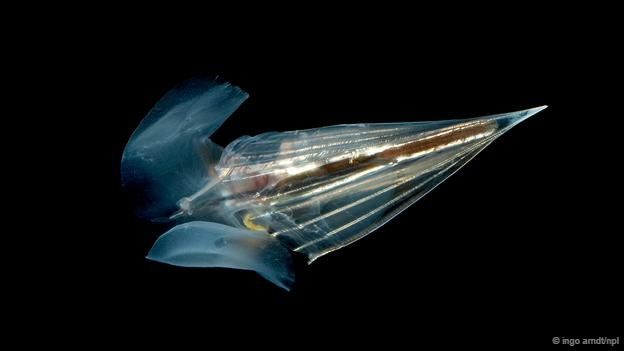
尖菱蝶螺, 一种海蝴蝶 (图片来源: Ingo Arndt/NPL)
海蝴蝶 ( 拉丁学名:Thecosomata)
海蝴蝶实际上是海蜗牛,它们居住在北极附近。
海蝴蝶有力的翼足并不是用来在海床爬行的,而用来在开放海域里游曳。这种改进了的翼足由两个圆形突出部分组成,看起来像是一对透明的薄翼。海蝴蝶就因这对“翼”的拍打动作而得名。
海蝴蝶的大多数品种都没有壳了,而有壳的那些也是全透明的。
海蝴蝶通过翼足上的粘液网来获取食物。这种网能有实际身体的五倍大小。在获得了足够的食物后,海蝴蝶会将这张网在吸回口中,以补充之前织网所消耗的养分。
海蝴蝶被认为替代了极地区域一半以上的浮游生物,为从青鱼到环斑海豹等一大批海洋生物提供食物。
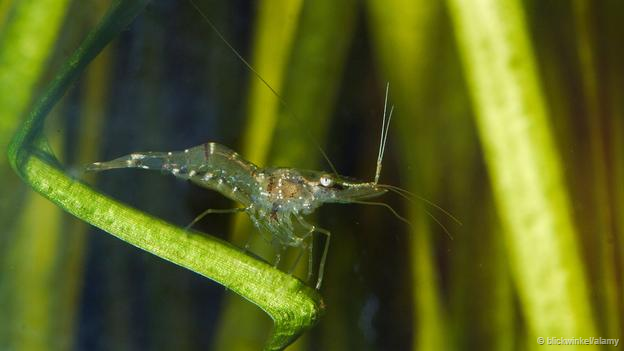
一只玻璃虾 (图片来源: blickwinkel/Alamy)
幽灵虾 ( 拉丁学名: Palaemonetes)
身体透明是大多数虾的特征。这些小甲壳类动物进化到几乎隐身,来躲避它们的捕食者。“幽灵虾”就是指这样几种小动物,其中最有名的就属淡水虾类。
淡水虾类一共有40多个不同种类,生活在世界上的淡水及淡海水水域。它们有时候也被称为“玻璃虾”,主要得名于它们半透明的外骨骼,也被称为“幽灵虾”,因为它们喜欢居住在海草里。
幽灵虾经常被当做宠物喂养,因为它们能清理掉鱼缸上的碎屑残渣。有些种类,你甚至能看到它们半透明的胃里的食物。在即将产卵的雌性幽灵虾体内,还能看到绿色的卵。
它们的眼睛是不透明的。感光性的视网膜只能捕捉光线,而不能让光线通过。但是,幼年期的草虾有一层金绿色的眼耀光,这层光能够遮挡住它们明显的黑色眼睛,以躲避捕食者。
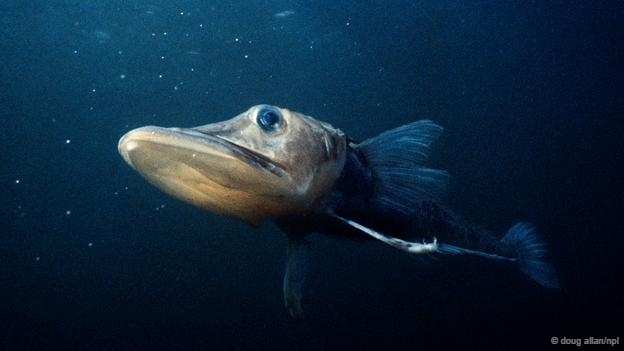
一条头带冰鱼 (拉丁学名:Chaenocephalus aceratus) (图片来源:Doug Allan/NPL)
南极冰鱼( 拉丁学名:Notothenioidei)
这种鱼生活在零下2摄氏度(华氏28.4度)、10米深的南太平洋海域,仿佛就是用海面上的冰造的一样。南极冰鱼已经完全适应了冰冷的海水,它们的血液和体液中甚至有一种抗冻蛋白质来防止凝固。
这种鱼外表苍白,并且多数有着半透明的皮肤。其中一个鳄头冰鱼属,身体里流淌的甚至不是红色血液。它们是已知的唯一一种无血红蛋白的鱼类,这种蛋白质在血液中输送氧气,并且使血液呈现红色。
一开始科学家们认为这也是它们适应生存环境的结果,但现在发现这是一个进化错误。冰鱼体内白色的血液携带氧气的量只相当于普通鱼红色血液的10%。因此,它们需要很大的心脏、很多的血液和密集的血管。
冰层以下的水域曾被认为不适合鱼类生存,但最近的研究揭示出冰鱼统治着南极海域,占到该区域物种量的35%。但是,海水温度目前急剧上升,冰鱼对冰冷海水的独特适应能力反而有可能使它们面临灭绝危险。
(责编:友义)
Ten animals that have evolved transparent bodies - Presented by Ella Davies
Glass octopus (Vitreledonella richardi)
The glass octopus is one of the most mysterious creatures around. It is an elusive, deep-dwelling species that is very nearly invisible in its marine home. Only the digestive organs and eyes are opaque.
Unlike the large round eyes of many of its deep-dwelling fellows, the glass octopus has eyes that almost appear rectangular from the side. They are effectively tubes with a lens at one end and retina at the other. The eyes point upwards to gather the residual daylight from the sky far above.
The cylindrical eye shape may help to disguise the octopus in the open ocean, where there is nowhere to hide. From underneath, the eyes cast a much smaller shadow than the half-globe eyes of other octopuses.
Japetella octopuses also appear transparent. They have an extra trick: they can defend themselves from predators that have their own light source. In 2011 scientists found they switch to a darker red appearance if a predator shines a light on them.
Glass frogs (Centrolenidae)
Glass frogs are found in Central and South America, particularly the cloud forests. They are named for their see-through skin.
Many of the 100 species in the family have translucent bellies, so you can see the shape of their organs, bones and blood vessels. In some species the visible bones are green, while in others the organs are also translucent.
It's not clear why their undersides are see-through. Their backs are bright green, and this helps them to blend into the verdant leaf canopies they call home.
A new species called Hyalinobatrachium dianae was discovered in 2015 by Brian Kubicki of the Costa Rican Amphibian Research Center in Guayacán and his colleagues. It is lime-green, resembles the muppet Kermit, and makes a long metallic whistling call.
At the time, Kubicki told the BBC that glass frogs are "delicate" species.
Moon jellyfish (Aurelia aurita)
While the moon jellyfish appears like a luminous globe in the light of an underwater photographer's flash, its name actually relates to the four horseshoe-shaped organs visible through its upper section or "umbrella". These are the reproductive organs. They appear white in males and pale pink in females.
It is arguably one of the most recognisable transparent animals – especially for European beachgoers, as it frequently washes up on shorelines.
When not lying like a slimy plastic bag by your sandcastle, the moon jellyfish floats near the surface of the water. There it traps plankton on its mucus-covered bell, and moves them to its mouth to gobble up.
It also dangles tentacles below the water to trap bigger meals. The tentacles, and the fringed edging of its umbrella, are covered with stinging cells that can stun passing small fish.
They don't cause humans much pain but moon jellyfish still cause problems. Several nuclear plants have had to shut down their reactors after their cooling systems became inundated with the brainless creatures. Large blooms of jellyfish may become commonplace.
Cyanogaster noctivaga
This fish hasn't been known long enough to earn a common name. Its Latin moniker means "blue-bellied night wanderer". This tells you something about its appearance and behaviour but leaves out the fact that, apart from the abdomen and head, it's almost completely transparent.
Many larval fish are transparent, as this disguises them before they reach maturity. C. noctivaga just doesn't grow out of it, nor does it grow to a great size.
Discovered in Brazil's Rio Negro in 2011, at its biggest it measures just 17mm (0.7in) long. That's only 7mm (0.3in) longer than the world's smallest fish, Sumatra's Paedocypris progenetica.
It was a surprising find, as scientists had thought its home, the largest tributary of the Amazon, had been thoroughly explored. Afterwards, researchers found more specimens in the University of Sao Paolo's Museum of Zoology. They had gone unnoticed for 30 years.
Sea walnut (Mnemiopsis leidyi)
If you move slowly, have no eyes or brain, and basically look like a transparent blob, you get called a sea walnut. This animal's common name was inspired by its apparent lifelessness.
It is not a jellyfish but a comb jelly. Rather than jet-propelling themselves through the water like jellyfish, comb jellies are powered by rows of microscopic, hair-like structures that vibrate. These look like combs, hence the name.
The sea walnut is transparent, but its combs scatter light into a rainbow of colours. In photographs this creates a web of pulsing neon rope lights. The animal also produces a blue-green bioluminescent glow, using specialised cells called photocytes.
They use their combs to trap prey, pushing water full of tiny plankton directly into the sea walnut's mouth. Sea walnuts are such voracious predators that they can dramatically affect food webs.
They were accidentally introduced to the Black Sea by cargo ships, and have eaten their way through much of its plankton, depriving animals like fish of food. Even the populations of large animals such as dolphins and seals have declined.
Glasswing butterfly (Greta oto)
Butterflies are known for standing out. Flashy, brightly coloured species like swallowtails rely on their eye-catching colour schemes to communicate and to secure mates.
Others do dress down, putting cryptic colours on the undersides of their wings to avoid predators. But none take it as far as the Central American glasswing butterfly. As you can guess, you can see straight through its wings.
The wild colours of butterflies are created by miniscule scales on their wings. But the glasswings have no scales on large portions of their wings, creating clear windows to the background behind them.
More impressively, the wings reflect so little light that not even a stray twinkle will give the butterflies away. This is a result of the wings' nanoscale structure.
A 2015 study described tiny pillar-like structures on the wings, the shapes and sizes of which are "chaotic". This arrangement resulted in substantially less reflection, and could be mimicked in future glare-free screens for computer monitors and smartphones.
Venus' flower basket (Euplectella aspergillum)
While plenty of see-through species get compared to glass, it's most accurate in the case of Venus' flower basket. Also known as the glass sponge, its skeleton is made of silica, the key material used to make glass.
The rigid body of the Venus' flower basket sticks out of the seabed into the cold waters of the western Pacific Ocean, at depths down to 1000m (328ft). It rises in a column of mesh to a height of 25cm (10in).
It looks like an intricate vase, hence the name. Water is sucked into the sponge's tissues and filtered for food particles.
The hollow body is occasionally home to shrimp, which enter as larvae but are trapped when they grow too large to escape. The shrimp then live imprisoned as monogamous pairs, making such sponges popular traditional wedding gifts in nearby Japan.
But once they leave the water, glass sponges literally pale in comparison with their former selves. They are lit by bioluminescence: in this case the glow is created by bacteria living on the sponges' surfaces.
Sea butterflies (Thecosomata)
Sea butterflies are actually marine snails that have adapted to life near the poles.
Rather than using its muscular foot to creep along the sea bed, a sea butterfly uses it to swim through open water. The modified foot is divided into two lobes and looks like a pair of transparent, flimsy wings. These "wings" flap, earning the animals their common name.
Many species of sea butterfly have lost their shells, and those that have kept them have made them completely clear.
Sea butterflies feed by deploying a net of mucus over their wings to trap food particles. This net can be five times the size of the actual snail. The sea butterfly sucks the nest back into its mouth afterwards, to recover the nutrients that went into making it.
Sea butterflies are said to make up more than 50% of the zooplankton in the polar seas, feeding a huge range of animals from herring to ringed seals.
Ghost shrimp (Palaemonetes)
See-through is a popular look among shrimp. These small crustaceans have evolved to become almost invisible to evade their predators. The term "ghost shrimp" is applied to several groups of animals, the largest being the genus Palaemonetes.
There are more than 40 different species of Palaemonetes, living in fresh and brackish water around the world. They are sometimes called "glass shrimp", thanks to their translucent exoskeletons, or "grass shrimp" because they like to live among weeds.
Ghost shrimp make popular pets, because they clean up tanks by feeding on detritus. In some species, you can see the food in their translucent stomachs. The green-tinted eggs can also be visible inside females' bodies before they spawn.
Their eyes are among their few opaque features. The light-sensitive retinas can only work by capturing light, rather than letting it pass through. However, larval daggerblade grass shrimp have a layer of greenish-gold eyeshine. This may mask their conspicuous black eyes from predators.
Antarctic icefish (Notothenioidei)
Living in 10m (32ft) below the surface of the Southern Ocean, where temperatures hover around -2 °C (28.4 F), are fish that seem to be made of the ice they swim beneath. Antarctic icefish are so well-adapted to the frigid waters, they even have an antifreeze glycoprotein in their blood and body fluids to stop ice crystals forming.
These fish are pale and many have translucent skin. One family, the crocodile icefish, do not even have red blood pumping through their veins. They are the only known backboned animals to lack haemoglobin, the protein that carries oxygen in the blood and makes it red.
At first this was thought to be another adaptation to their frosty home, but scientists now suspect it is an evolutionary error. With their cloudy white blood, the icefish can only transport 10% as much oxygen as red-blooded fish. To compensate they need large hearts, lots of blood and dense nets of blood vessels.
The waters beneath ice sheets were once considered inhospitable for fish, but recent surveys have revealed that icefish dominate Antarctic waters, comprising up to 35% of the biomass. However, sea temperatures are now rising rapidly, and their unique adaptations to cold waters could put them at risk of extinction.